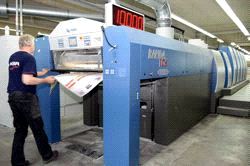Offset Printing
Cutting-edge technology in northern Bavaria

Friday 19. July 2013 - Rapida 106 at Spintler Druck und Verlag in Weiden, Germany
Printing firms have to adapt to current developments brought on by technological advancements and fundamental shifts in the market as well as actively shaping their future and anticipating new trends.
Spintler Druck und Verlag in Weiden, Germany, is a prime example of a company which not only embraces new processes but is also committed to actively shaping them.
As the name suggests, Spintler printing and publishing house once published and produced its own local newspaper. The title was dropped 20 years ago. This was followed by form printing which boomed from 1990 to 2000. At that time sheetfed offset barely amounted to between 10 and 20 per cent of production. Today continuous form printing and letterheads on a web press each make up 10 per cent of production and 80 per cent is now produced on sheetfed offset or digital presses.
Mixed products from digital and offset
One of the company’s strengths is mixed products from digital and offset. This includes various semi-personalised items ranging from mailings to personalised packaging. Production varies from one up to 50,000 copies. For example, in digital printing three or four packaging designs can be produced as samples before the main job starts. Even small runs are processed on laser stampers and cutting plotters. In addition, the company also has special stampers, folding and stitching machines as well as finishing systems for self-mailers at its disposal. The majority of the production steps take place in house, including inserting by hand. The more complex the production, the better it is suited to Spintler’s portfolio. The 50-strong company receives orders from all over Germany. However, the company’s customer base consists mainly of insurance firms, ad agencies and larger publishing houses.
This shift is also apparent in the firm’s press room. The recent installation of a five-colour Rapida 106 with coater signals a change in systems now that the company’s main press is from KBA. Managing director Thomas Leckert opted for this press due to KBA’s cutting-edge innovation in sheetfed offset and the better standard of customer care offered. The cost per printed sheet was also a deciding factor. “In this respect KBA was once again one step ahead of the competition”, Leckert explains.
More output thanks to cutting-edge technology
The new press can handle 60g/m² paper as well as board up to approx. 800g/m². The press format is engineered to accommodate last minute decisions as to whether a job is to be printed on the Rapida or on another medium-format press. The press also features a fully automated plate-changing system. Substrates are changed nearly every hour, as the company focuses on individuality. Today jobs are ready for print in 12 to 15 minutes, in comparison to the up to 1.5 hours of “tinkering” which was needed in the past. Thanks to the Rapida 106’s sidelay-free infeed and extensive press preset functions, time is saved effortlessly Nearly all jobs are ready to be printed after the first proof. Rapida inline quality control with QualiTronic ColorControl also plays its part in ensuring quality from the first to the last sheet, which means that hardly any sheets end up in the waste paper bin. Only a few months after the Rapida 106 was fired up, production output has increased by 20 per cent to 25 per cent and continues to rise.
UV finishing, which up until now was done externally, is also new at Spintler. A huge amount of time is saved as all processes can be done inline. The firm predominantly prints with conventional inks, a primer is applied and products are then finished with UV coating.
Ecological processes throughout
The Rapida 106, with its low power consumption, has also has brought about major ecological advances. Generating power in the company’s own block heat and power plant so that even finishing can be carried out without negatively effecting CO² levels. Spintler also produces considerable amounts of solar power. Plates are produced process-less and without chemicals. The use of printing aids and amount of ink has been cut, plus the press room also benefits from the press’ glycol cooling system. What is more, Spintler Druck und Verlag offers environmentally-friendly printing, an offer taken up mainly by larger publishing houses and insurance firms. The company was also, of course, been PSO- and FSC-certified many years ago.
Thomas Leckert always keeps a close eye on market changes and industry developments. He is particularly interested in combinations and interfaces between digital and offset printing. The company can now make the most of its strengths with its press fleet consisting of three sheetfed offset and four digital presses (with two more at a subsidiary).
